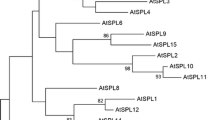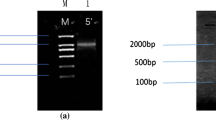Abstract
In many plant species, exposure to a prolonged period of low temperature during the winter promotes flowering in the spring, a process termed vernalization. In Arabidopsis, the vernalization requirement of winter annual ecotypes is caused by a MADS-box gene FLOWERING LOCUS C (FLC), which is a repressor of flowering gene. Here, a MADS-box gene was isolated from an early flowering trifoliate orange mutant (precocious trifoliate orange, Poncirus trifoliata L. Raf) by the RACE method combined with a cDNA library. Phylogenetic analysis reveals that the MADS-box gene is more closely related to the homologs of the FLOWERING LOCUS C lineage than to any of the other MIKC-type MADS-box lineages known from Arabidopsis. The expression profile of the MADS-box gene by real-time PCR showed upregulation of PtFLC during the winter, followed by a decrease in the spring and summer. This kind of cycling is contrary to the pattern observed in Arabidopsis. In situ hybridization reveals that the MADS-box gene is predominately expressed in the vegetative and reproductive meristems. In addition, five alternatively spliced transcripts of the MADS-box gene were also isolated at juvenile and adult mutant developmental stages. Expression analysis of these transcripts at different developmental stages indicated involvement of alternative splicing during phase change. The information suggests a complicated regulation mechanism in seasonal response and flower formation in perennial woody plants.







Similar content being viewed by others
Abbreviations
- FLC:
-
FLOWERING LOCUS C
- SSH:
-
Suppression subtractive hybridization
- UTR:
-
Untranslated region
- SAM:
-
Shoot apical meristem
References
Altman A, Goren R (1974) Growth and dormancy cycles in Citrus bud cultures and their hormonal control. Physiol Plant 30:240–245
Angiosperm Phylogeny Group (2003) An update of the Angiosperm Phylogeny Group classification for the orders and families of flowering plants: APG II. Bot J Linn Soc 141:399–436
Balasubramanian S, Sureshkumar S, Lempe J, Weigel D (2006) Potent induction of Arabidopsis thaliana flowering by elevated growth temperature. PLoS Gene 2:e106
Bastow R, Mylne JS, Lister C, Lippman Z, Martienssen RA, Dean C (2004) Vernalization requires epigenetic silencing of FLC by histone methylation. Nature 427:164–167
Becker A, Theissen G (2003) The major clades of MADS-box genes and their role in the development and evolution of flowering plants. Mol Phylogenet Evol 29:464–489
Chaikiattiyos S, Menzel CM, Rasmussen TS (1994) Floral induction in tropical fruit trees: effects of temperature and water supply. J Hort Sci 69:397–415
Chen K, Coleman G (2006) TypeII MADS-box genes associated with poplar apical bud development and dormancy. Abstract presented at the American Society of Plant Biologists Meeting, Boston MA, USA, 5–9 August 2006 (http://abstracts.aspb.org/pb2006/public/P03/P03015.html)
Cheng Y, Kato N, Wang W, Li J, Chen X (2003) Two RNA binding proteins, HEN4 and HUA1, act in the processing of AGAMOUS pre-mRNA in Arabidopsis thaliana. Dev Cell 4:53–66
Curtis OF, Chang HT (1930) The relative effectiveness of the temperature of the crown as contrasted with that of the rest of the plant upon the flowering of celery plants. Am J Bot 17:1047–1048
Davenport T (1990) Citrus flowering. Hort Rev 12:349–408
DeBodt S, Raes J, Florquin K, Rombauts S, Rouze P, Theißen G, Peer Y (2003) Genome wide structural annotation and evolutionary analysis of the type I MADS-box genes in plants. J Mol Evol 56:573–586
Drews GN (1998) In situ hybridization. Methods Mol Biol 82:353–371
Du X, Xiao Q, Zhao R, Wu F, Xu Q, Chong K, Meng Z (2008) TrMADS3, a new MADS-box gene, from a perennial species Taihangia rupestris (Rosaceae) is upregulated by cold and experiences seasonal fluctuation in expression level. Dev Genes Evol 218:281–292
Evgenia V, Koch IK, Apweiler R, Vingron M, Bork P, Gelfand SM, Sunyaev S (2003) Increase of functional diversity by alternative splicing. Trends Genet 19:125–128
García-Luís A, Kanduser M (1995) Changes in dormancy and sensitivity to vernalization in axillary buds of satsuma mandarin examined in vitro during the annual cycle. Ann Bot 76:451–455
García-Luís A, Kanduser M, Santamarina P, Guardiola JL (1992) Low temperature influence on flowering in citrus. The separation of inductive and bud dormancy releasing effects. Physiol Plant 86:648–682
He YH, Michaels SD, Amasino RM (2004) Regulation of flowering time by histone acetylation in Arabidopsis. Science 302:1751–1754
Hu CG, Honda C, Kita M, Zhang ZL, Tsuda T, Moriguchi T (2002) A simple protocol for RNA isolation from fruit trees containing high levels of polysaccharides and polyphenol compounds. Plant Mol Biol Rep 20:69a–69g
Judd WS, Olmstead RG (2004) A survey of tricolpate (eudicot) phylogenetic relationships. Am J Bot 91:1627–1644
Kofuji R, Sumikawa N, Yamasaki M, Kondo K, Ueda K, Ito M, Hasebe M (2003) Evolution and divergence of the MADS-box gene family based on genome-wide expression analyses. Mol Biol Evol 20:1963–1977
Kuhn JM, Breton G, Schroeder JI (2007) mRNA metabolism of flowering-time regulators in wild-type Arabidopsis revealed by a nuclear cap binding protein mutant, abh1. Plant J 50:1049–1062
Lee J, Cho Y, Yoon H, Suh M, Moon J, Lee I, Weigel D, Yun C, Kim J (2005) Conservation and divergence of FCA function between Arabidopsis and rice. Plant Mol Biol 58:823–838
Lang GA (1987) Dormancy: a new universal terminology. HortScience 22:817–820
Liang SQ, Zhu WX, Xiang WT (1999) Precocious trifoliate orange (Poncirus trifoliata L. Raf.) biology characteristic and its stock experiment. ZheJiang Citrus 16:2–4 (In Chinese)
Lightfoot DJ, Malone KM, Timmis JN, Orford SJ (2008) Evidence for alternative splicing of MADS-box transcripts in developing cotton fibre cells. Mol Genet Genome 279:75–85
Lona F (1968) Intra-reproductive vernalization in Soldanella minima. Planta 82:145–152
Lorkovic ZJ, Kirk DA, Lambermon MH, Filipowicz W (2000) Pre-mRNA splicing in higher plants. Trends Plant Sci 5:160–167
Lopato S, Kalyna M, Dorner S, Kobayashi R, Krainer AR, Barta A (1999) atSRp30, one of two SF2/ASF-like proteins from Arabidopsis thaliana, regulates splicing of specific plant genes. Gene Dev 13:987–1001
Metzger JD (1988) Localization of the site of perception of thermoinductive temperatures in Thlaspi arvense L. Plant Physiol 88:424–428
Michaels S, Amasino RM (1999) FLOWERING LOCUS C encodes a novel MADS domain protein that acts as a repressor of flowering. Plant Cell 11:949–956
Nam J, Kim J, Lee S, An G, Ma H, Nei M (2004) Type I MADS-box genes have experienced faster birth-and-death evolution than type II MADS-box genes in angiosperms. Proc Natl Acad Sci USA 101:1910–1915
Nishikawa F, Endo T, Shimada T, Fujii H, Shimizu T, Omura M, Ikoma Y (2007) Increased CiFT abundance in the stem correlates with floral induction by low temperature in Satsuma mandarin (Citrus unshiu Marc.). J Exp Bot 58:3915–3927
Parenicová L, deFolter S, Kieffer M, Horner DS, Favalli C, Busscher J, Cook HE, Ingram RM, Kater MM, Davies B, Angenent GC, Colombo L (2003) Molecular and phylogenetic analyses of the complete MADS-box transcription factor family in Arabidopsis: new openings to the MADS world. Plant Cell 15:1538–1551
Perry T (1971) Dormancy of trees in winter. Science 171:29–36
Piwarzyk E, Yang YZ, Jack T (2007) Conserved C-terminal motifs of the Arabidopsis proteins APETALA3 and PISTILLATA are dispensable for floral organ identity function. Plant Physiol 145:1495–1505
Quesada V, Macknight R, Dean C, Simpson GG (2003) Autoregulation of FCA pre-mRNA processing controls Arabidopsis flowering time. EMBO J 22:3142–3152
Rebecca SL, Irish V (2003) Functional divergence within the APETALA3/PISTILLATA floral homeotic gene lineages. Proc Natl Acad Sci USA 100:6558–6563
Reddy A (2001) Nuclear pre-mRNA splicing in plants. Crit Rev Plant Sci 20:523–571
Reeves PA, He Y, Schmitz RJ, Amasino RM, Panella LW, Richards CM (2007) Evolutionary conservation of the FLOWERING LOCUS C-mediated vernalization response: evidence from the sugar beet (Beta vulgaris). Genetics 176:295–307
Rijpkema A, Gerats T, Vandenbussche M (2007) Evolutionary complexity of MADS complexes. Curr Opin Plant Biol 10:32–38
Rohde A, Bhalerao RP (2007) Plant dormancy in the perennial context. Trends Plant Sci 12:217–223
Schwabe W (1954) Factors affecting flowering in Chrysanthemum IV. The site of vernalisation and translocation of the stimulus. J Exp Bot 5:389–400
Sergio G, Avila CN, García-Luís A, Guardiola JL (2006) Seasonal variation in the competence of the buds of three cultivars from different Citrus species to flower. Trees 30:507–514
Sheldon CC, Burn JE, Perez PP, Metzger J, Edwards JA, Peacock WJ, Dennis ES (1999) The FLF MADS box gene: a repressor of flowering in Arabidopsis regulated by vernalization and methylation. Plant Cell 11:445–458
Sheldon CC, Rouse DT, Finnegan EJ, Peacock WJ, Dennis ES (2000) The molecular basis of vernalization: the central role of FLOWERING LOCUS C (FLC). Proc Natl Acad Sci USA 97:3753–3758
Shore P, Sharrocks AD (1995) The MADS-box family of transcription factors. Eur J Biochem 229:1–13
Simpson GG, Dean C (2002) Arabidopsis, the Rosetta stone of flowering time? Science 296:285–289
Simpson GG, Filipowicz W (1996) Splicing of precursors to mRNA in higher plants: mechanism, regulation and sub-nuclear organisation of the spliceosomal machinery. Plant Mol Biol 32:1–41
Soltis PS, Soltis DE (2004) The origin and diversification of angiosperms. Am J Bot 91:1614–1626
Tadege M, Candice CS, Helliwell CA, Stoutjesdijk P, Dennis ES, James W (2001) Control of flowering time by FLC orthologues in Brassica napus. Plant J 28:545–553
Tian ZD, Liu J, Xie CH (2003) Cloning of a pathogenesis related protein gene cDNA of potato using RACE methods combined with cDNA library. Acta Genetica Sinica 30:996–1002
Wang BB, Brendel V (2006) Genome wide comparative analysis of alternative splicing in plants. Proc Natl Acad Sci USA 103:7175–7180
Acknowledgments
This research was supported financially by the National Natural Science Foundation of China (grant nos. 30370996, 30671434) and the 863 project of China (grant no. 2007AA10Z188).
Author information
Authors and Affiliations
Corresponding author
Additional information
J.-Z. Zhang and Z.-M. Li contributed equally to this work.
Rights and permissions
About this article
Cite this article
Zhang, JZ., Li, ZM., Mei, L. et al. PtFLC homolog from trifoliate orange (Poncirus trifoliata) is regulated by alternative splicing and experiences seasonal fluctuation in expression level. Planta 229, 847–859 (2009). https://doi.org/10.1007/s00425-008-0885-z
Received:
Accepted:
Published:
Issue Date:
DOI: https://doi.org/10.1007/s00425-008-0885-z




